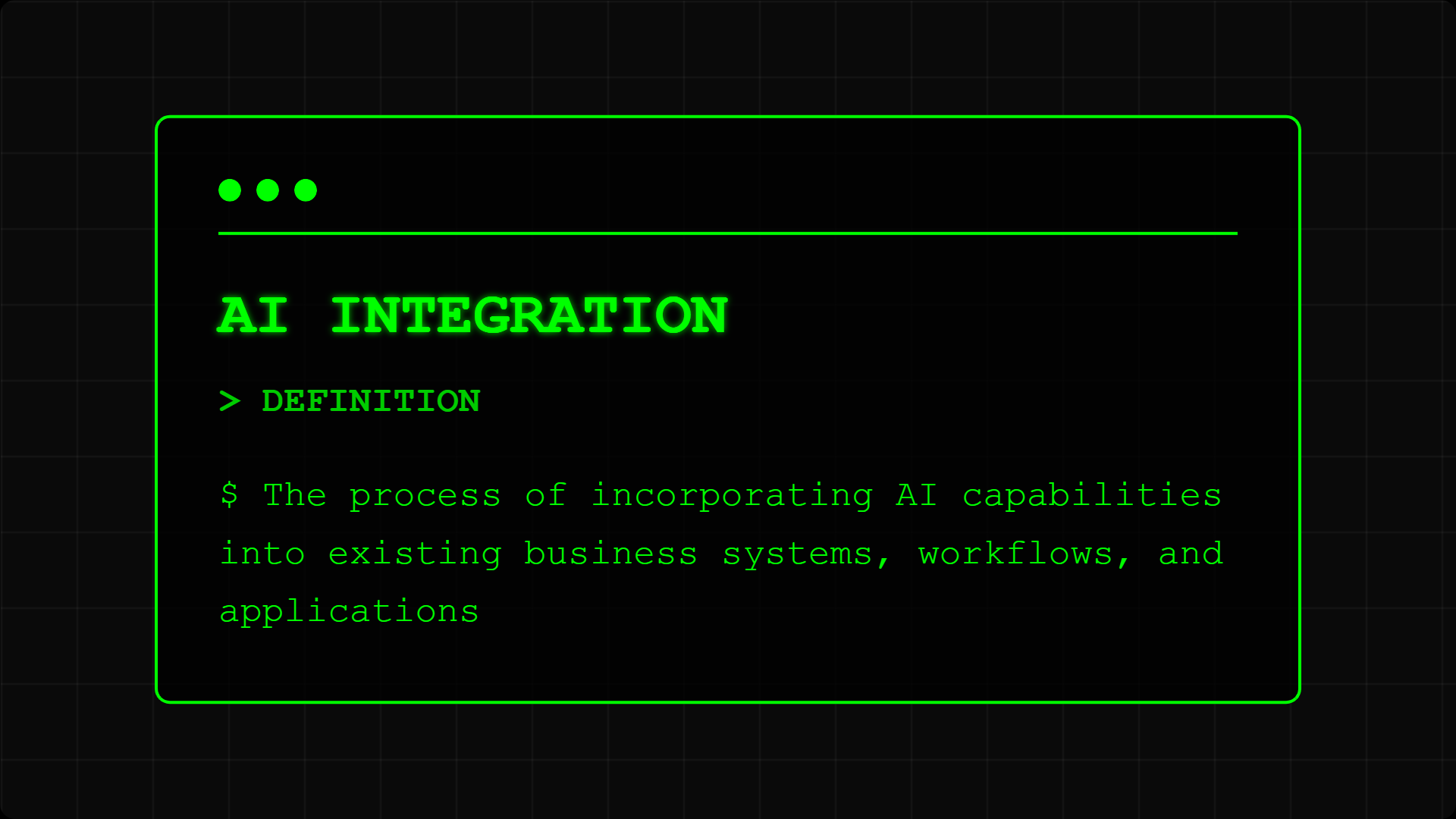AI Terms
What is AI Integration? Making AI Work with What You Have

You've invested millions in your current systems. Now AI promises transformation, but ripping everything out isn't an option. AI integration solves this dilemma, enabling you to embed intelligent capabilities into existing operations without starting from scratch.
Background and Definition
AI integration emerged as a discipline in the early 2010s when businesses began moving beyond AI experiments to production deployments. The term combines traditional systems integration with AI deployment practices.
According to Gartner, AI integration is defined as "the process of embedding AI capabilities into existing business applications, processes, and workflows to augment human decision-making and automate complex tasks while maintaining operational continuity."
The field evolved from simple API connections to sophisticated orchestration as organizations realized that successful AI requires more than just plugging in algorithms. It demands thoughtful melding of intelligent systems with established operations.
The Business Reality
For business leaders, AI integration means seamlessly embedding artificial intelligence into your existing technology stack and business processes, like adding a turbocharger to your engine rather than buying a new car.
Think of AI integration as giving your current systems superpowers. Your CRM doesn't disappear; it gains the ability to predict customer behavior. Your ERP doesn't change; it starts optimizing inventory automatically. Your email doesn't look different; it just gets dramatically smarter.
In practical terms, this means enhancing what works rather than replacing everything, achieving AI benefits while protecting existing investments.
Integration Building Blocks
AI integration consists of these essential elements:
• Data Connectors: Bridges that allow AI to access information from existing systems (databases, applications, IoT devices) without disrupting operations
• Processing Layer: The AI engine that analyzes data and generates insights, could be cloud-based, on-premise, or hybrid depending on security needs
• Integration Middleware: Software that translates between AI outputs and existing system requirements, ensuring compatibility and smooth operation
• Workflow Orchestration: Tools that coordinate when and how AI intervenes in business processes by triggering actions, routing decisions, managing exceptions
• Monitoring Framework: Systems tracking integration performance, data quality, and business impact, essential for optimization and troubleshooting
The Integration Process
The AI integration process follows these steps:
System Assessment: Map current technology landscape and identify integration points. Where can AI add most value with least disruption?
Data Pipeline Creation: Establish secure, reliable data flows from source systems to AI platforms, ensuring quality, governance, and real-time access where needed
Intelligence Embedding: Deploy AI models that enhance existing processes by adding prediction to reporting, automation to workflows, or insights to dashboards
This creates an intelligent nervous system where AI augments rather than replaces, enhancing decision-making and automation throughout the organization.
Four Integration Patterns
AI integration generally falls into four main patterns:
Type 1: Embedded Intelligence Best for: Enhancing existing applications Key feature: AI features built directly into current tools Example: Salesforce Einstein adding AI to CRM workflows
Type 2: API Integration Best for: Flexible, modular deployment Key feature: AI services accessed through programming interfaces Example: Adding ChatGPT to customer service systems
Type 3: Data Layer Integration Best for: Analytics and insights Key feature: AI analyzes data without changing applications Example: Predictive analytics on existing data warehouse
Type 4: Process Automation Best for: Workflow optimization Key feature: AI orchestrates between multiple systems Example: Intelligent document processing across departments
Integration Success Stories
Here's how businesses actually integrate AI:
Retail Example: Walmart integrated AI into its existing inventory system, adding demand prediction without replacing core infrastructure, reducing out-of-stocks by 30% while cutting waste by 20%.
Financial Example: HSBC integrated AI fraud detection into transaction processing, analyzing patterns in real-time without changing the core banking system, catching 95% of fraud with 50% fewer false positives.
Manufacturing Example: GE integrated predictive maintenance AI with existing equipment sensors, predicting failures 45 days in advance without replacing machinery, saving $200 million annually.
Your Integration Journey
Ready to integrate AI into your existing systems?
- Start with AI Automation for process enhancement
- Understand API Architecture for technical integration
- Explore Data Pipeline Design for information flow
- Follow our AI Integration Roadmap
Part of the [AI Terms Collection]. Last updated: 2025-01-10